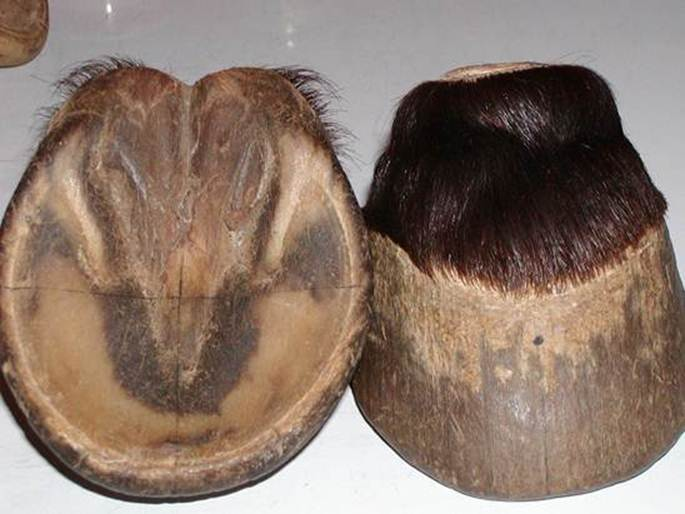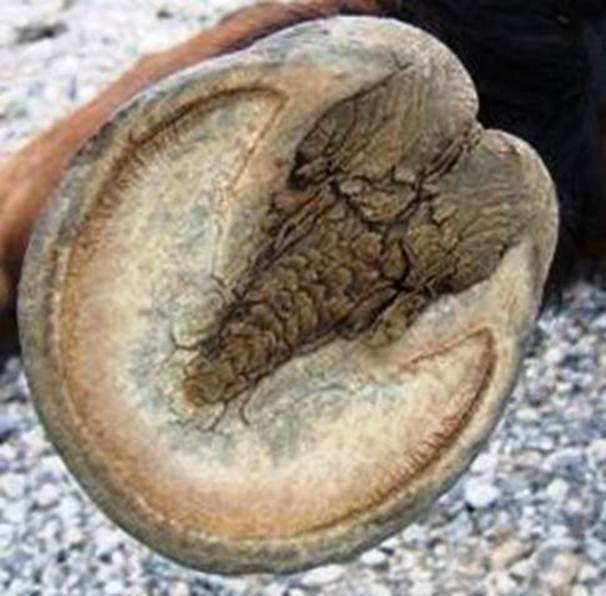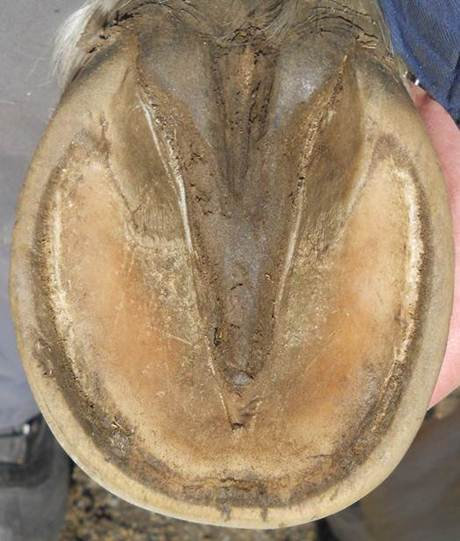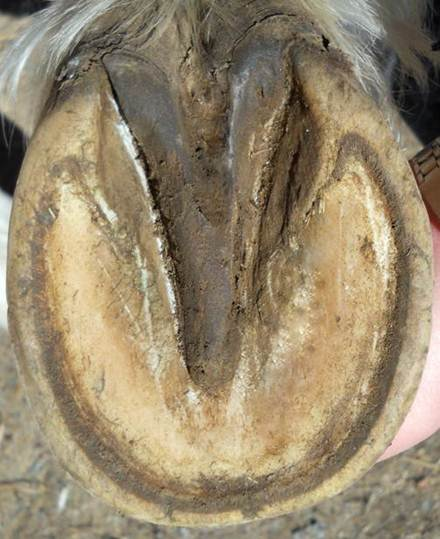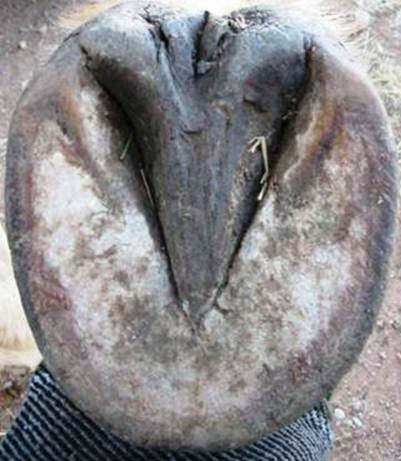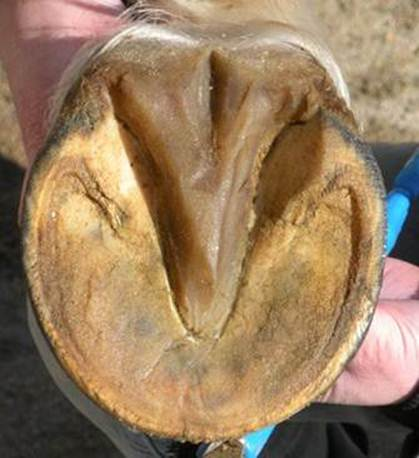Barefoot – Fad or New Age Hoofcare?by Heike BeanThe equine barefoot movement is becoming rapidly a widely known hoof care modality and is in the process of revolutionizing the lives of many domestic horses and their owners. It’s very origins date back to 1988, when Les Emery and Jamie Jackson presented a large amount of data about their research on wild horse feet at the 1988 convention of the American Farrier’s Association in Lexington, Ky. With the release of Jamie Jackson’s book “The Natural Horse” this information became more widely known and available for horse owners. Gene Ovnicek contributed with his wild horse research, and Dr. Hiltrud Strasser catered even more to the horse owner with her ground breaking book “Lifetime of Soundness”, published in 1998. Like many new or unusual ideas, at its beginning this movement was ridiculed, dismissed as a fad and outright maligned as supposed cruelty to horses (and still is). Nevertheless it has gained enormous momentum and is proving itself more and more as a solution for reversing and preventing commonly believed incurable hoof diseases like navicular, founder, club feet, ringbone and contracted heels. Of course this type of hoof care is equally beneficial to any sound horse, whether young and growing, or any other age. How is this way of caring for hooves different from just keeping a horse unshod? This question is asked by many horse owners and traditional hoof care providers and cannot be answered in a few words, matter of fact, one could write a book about it. In a nut shell, one could say the main difference is the realization of the connection between healthy hooves and a healthy and natural life style, including living conditions, exercise, nutrition, and emotional well being of the horse. Hoof care used to be something few owners of equines directly concern themselves with. Regularly scheduled visits from a farrier were all that was deemed necessary to take care of this aspect of equine health. Lameness was something that happened for mostly unknown reasons, and a veterinarian took care of that aspect when necessary. Now, all of a sudden, different researchers pointed to the connection of domesticity -- and the corresponding changes to a natural horse’s diet -- and some aspects of traditional hoof care as major culprits when problems with soundness arose. They also advocated that horse owners could and actually should take a big part in maintaining the soundness of their horses. So, instead of remaining uninvolved bystanders, horse owners are taught about hoof anatomy, hoof function, hoof distortion and correct hoof form, and are encouraged to be the custodians of their horses’ hooves. Many owners have even learned to trim their horses themselves and are doing a great job at it. The major benefit of this is that hooves can be trimmed as often as necessary to prevent any distortions or to reverse previous distortions like the low heel/long toe syndrome. Often weekly to biweekly touchups will greatly speed up the healing process when needed. Most professional hoof care providers would be unable to keep up such a schedule, and the cost to the owner would also be considerable. Owners are also educated about the impact of structural misalignments caused by tight muscles, subluxations and poorly balanced teeth. All these factors can influence the way a horse uses his body and thus affect hoof distortion. Another difference between the “new” barefoot trim and traditional hoof care is the way the hoof is actually trimmed. Barefoot trimmers have many more parameters when trimming a hoof than most conventional farriers, and usually have a very in-depth knowledge of the structures inside the hoof capsule. The goal of a good barefoot trim is to position the coffin bone correctly inside the hoof capsule so that it is slightly elevated in the back and is evenly balanced from side to side. Frogs are allowed to be fully in ground contact, and walls are trimmed very close to sole level so the sole is also weight bearing. The hoof is basically encouraged to have low heels and short toes and to be as compact as possible. The hoof capsule is supposed to be a mirror image of the structures inside. Heels are moved back to the widest part of the frog, and the distance from the tip of the frog to the toe wall is kept as short as possible to prevent leverage from the toe wall against the coffin bone. Walls are rounded into a mustang roll to prevent cracking and chipping. Hind hoofs must measure at a steeper angle than front hooves as this is how nature designed the underlying coffin bones. The pictures of wild horse cadaver feet demonstrate the origin of this principle. These hooves are from dry and arid desert terrain. Of course not all wild hooves look exactly this way as terrain plays a huge role. But for our unnatural demands on our domestic horses, this form was deemed the most beneficial and appropriate model for attaining and maintaining soundness and it’s underlying principles haven proven themselves over the last 20 years or more. Wild horse cadaver hooves from the collection of Jaime Jackson
Wild horse hoof from the collection of Pete Ramey. Note the different look of sole and frog, but the hoof form is very similar. This horse lived on less abrasive terrain.
Domestic hooves can come pretty close, even under the wet conditions of Vermont. These hooves are from a 14 y old Arab/X, sound on any terrain.
More domestic front hooves from various terrains
The horse is also observed during movement and great emphasis is put on the way the hooves impact on level ground. The main goal is the all important heel first landing . All structures within the equine hoof are calibrated for this initial loading of the hoof. All the shock absorbing structures are located in the back part of the hoof. Toe first landing on level ground is a definite sign of unsoundness. It is very detrimental to the health of joints and soft tissues and is a major cause or lameness. (Please note that all horses will land toe first when going uphill and heel first when going downhill. They have no other choice due to the mechanics in their legs.) Natural Life Style As already mentioned, a critical component of barefoot hoof care is that hooves are not considered to be an isolated part of the horse, rather, they are the most vitally important part of the horse's anatomy. Hooves are not merely the outer visible horn shell; they connect the entire body with the ground and give the horse its valued attributes of speed and agility. Everyone has heard the old adage: no hoof, no horse. The outer horn shell protects highly vascular and incredibly vulnerable inside structures, consisting of bones, tendons, ligaments, cartilage, nerves and an astounding amount of blood vessels. Horn is nothing but hardened skin and is constantly being produced. Ideally, it is produced at the same rate as it is worn off, thus ensuring a healthy covering of the inside structures without excess wear or excess accumulation of horn. We all know that horse shoes have been invented to protect from excess wear and that excess accumulation makes the trimming of hooves necessary. Wild horses do not have the luxury of this assistance, and yet they seem to be able to take care of their own hooves, and this is where the first barefoot proponents began to find vital clues to better hoof care. While their findings were almost as diverse as the terrain the horses lived on, one important denominator became apparent: MOVEMENT. Wild horses are constantly on the move: to forage, find water, find mineral licks, and so forth. But contrary to common belief, horses are not always on the run; as a matter of fact, they usually just walk, and only go faster if provoked, be it by perceived danger, an intruder to the herd--like an outside stallion trying to usurp the herd monarch or steal a mare or two--or youngsters learning life skills through playful banter. One of the most important discoveries that came out of this research was what makes horn grow: ample circulation, thus bringing new nutrients to the cells. Now this may not seem a big surprise, but in order to achieve the circulation for superior horn growth the horse needs to move. Horses have no muscles below the knee and hock and thus rely on the motion of impact of the hoof on the ground to transport blood back up the leg. Their vascular system in the hoof is constructed in a way that during the flight phase of the hoof new blood rushes into the hoof, and during the impact phase it gets pressed out of the hoof and back to the heart. Of course, hooves are always suffused with blood, even if a horse lives all his life in a stall, otherwise there would be no hooves. But in order to have strong and healthy horn that can withstand abrasion and impact, constant exchange of blood and nutrients is necessary. The terrain also plays a role in horn growth. Wild horses live on a certain terrain, and their hooves adapt to this. Studies have been done changing wild horses from one terrain to another, and within a few months, the hooves had totally adapted to the new terrain. So there are already 2 strikes against our domestic horses: they don’t get nearly enough movement (at least 10 miles per day of slow and constant progression) and they usually live on a totally different terrain than we expect them to work on. A third strike is that we often ask for one hour or so of heavy and sustained exercise, and then nothing for the rest of the day. Horses in the wild barely ever run for more than a few minutes at a time. Due to increased awareness of these factors, more and more horse owners are providing their horses with a more natural environment, consisting of free movement 24/7, adequate shelter from the elements and room to roam. Even with limited space, owners are finding many creative ways to provide their horses with room for movement and incentive to move. They create interesting mazes, a track around the outside of their property, or make a small area interesting by varying terrain, for example, adding a big pile of sand or small stones, since horses love to climb on piles and dig around in them. They also provide the horses with toys, and of course keep them in company of others to satisfy their social needs and their desire to interact. Googling Paddock Paradise will provide ample suggestions. Owners have also become aware that hygiene of the hoof is of great importance, and that it is up to them to treat or prevent fungal and bacterial infections, commonly called called thrush and white line disease. Nutrition Adequate nutrition plays another huge role in hoof health, not just to grow healthy horn, but also to prevent the so dreaded occurrence of laminitis and founder. Most horse owners still think that only an overindulgence of grass or grain is responsible for this painful condition. Thanks to good research we know much better. For example, the presence and amount of certain minerals and the proper ratio amongst corresponding minerals like calcium and phosphorus, and copper and zinc, play a huge role in the overall health of the horse and thus the hoof, and hay and poor looking pasture can still prove too sugar rich, thus starting the destructive process in the horse’s hind gut that leads to laminitis or founder. While I am on this topic, there are many other factors that can cause laminitis, many of which are subject to management by the horse owner and can be prevented or minimized. I will just mention a few here that may not be so well known: obesity, metabolic syndrome/insulin resistance, Equine Cushing's Disease, "stress" -- usually that of long journeys, separation from a pasture buddy, vaccination or worming -- plant poisoning, and iron overload due to an imbalanced micro mineral intake. The best trim cannot cure founder if the horse has hormonal or metabolic issues and if the diet is not optimized and/or the cause of the founder removed. But this is exactly why the “new” barefoot trim is so successful: hoof care providers understand the connection between founder and life style and educate the owner. It is pretty much done on a routine basis now, and many “hopeless” cases have been restored to full soundness. By fixing the diet, together with the correct trim where the compromised hoof structure is optimally balanced and maintained to minimize lever forces between the coffin bone and the horny capsule (often done on a weekly basis), horses quickly become pain free and are set up to heal. Another fairly new discovery is that of chronic low grade laminitis. This type of laminitis goes very often totally unrecognized and is frequently confused with other hoof ailments, the most common that the horse has thin and sensitive soles, or navicular, and thus requires shoes. Usually hooves show no outward changes with this type of laminitis, and even radiographs cannot detect anything unusual. Blood tests, checking for insulin resistance and Cushings, and review of the diet usually quickly reveal the source and the problem can be taken care of. Putting shoes on such a horse may actually make matters worse due to the peripheral loading of the hoof wall and the fact that the problem is just covered up and its source is not being addressed. Besides diet a healthy immune system is the next very important key to prevent and cure laminitis and founder, which in turn is again related to diet. The immune system is essentially located in the hind gut of the horse and consists of the healthy condition of the gut flora. This aspect is not well known and often overlooked. The best way to maintain this flora is through a proper feeding regimen, designed by understanding the needs of the horse. The horse is a grazing and browsing animal and has a great need to keep his intestines filled with a constant and varied flow of forage. Their stomachs are very small and empty very quickly-- within 2 to 4 hours. So when horses are without any food for about 4 hours, they will be ravenous and their intestinal health is at great risk. Under such conditions not only do their stomachs secrete too much acid, which leads to ulcers, but also, when their long intestinal tracts are not filled consistently gas pockets develop, leading to gas pain and possible twists of the intestines and fatal colic. The associated physical and emotional stress also has a negative impact on the gut flora and thus the immune system. The type of food ingested is also of great importance. Horses do best on a diet of mixed grasses or grass hay with a protein content of about 8 or 9 percent and low sugar content. Grains are not a necessary food unless the hay does not provide enough protein, or when hard working horses need more calories than hay can provide. If grains are fed, only whole grains should be used, without any added sugars like molasses, and never large amounts at a time. Horses are very sensitive to sugar ( the starch in grain turns into sugar), their metabolism is easily offset by it and insulin resistance is a very common side effect of too much sugar in the diet. Thus, most commercially produced horse feeds are very unsuitable. Considering the traditional feeding methods of horses it easily becomes evident how much physical and emotional stress can be created or avoided just from this aspect alone. For more information, the reader may want to go to http://www.heikebean.com/nutrition.htm and read up more on this subject. On the other hand, unfortunately, grazing 24/7 can also be very detrimental for our horses. When there is too much food available they overeat, just like humans at smorgasbords. Young horses, brood mares and certain breeds can do well with this, but many breeds and mature horses become obese and insulin resistant, and as a result have chronic laminitis or founder, especially if not regularly exercised. It is a delicate balance between providing the horse with the constant required fiber flow and not overfeeding him. To make matters worse, overgrazed areas where almost nothing grows, may be the worst of all. The more stressed grass is, as through drought, lack of nutrients and overgrazing, the higher the sugar content. So many owners, believing to offer a safe area to their animals, are more than shocked to find their equine laminitic and have no explanation. Is barefoot only for horses with a natural life style? Of course not; barefoot is usually always better for horses than having metal nailed to their feet. Most any farrier will readily agree with this. Metal shoes unquestionably restrict the natural flexibility of the hoof capsule and do not allow for any natural wear of the hoof, thus distorting the hoof capsule from one reset to the next. Bare hooves can be touched up weekly if necessary to maintain optimum hoof form and balance. There are instances where very weak and compromised hooves benefit from some kind of nailed or glued on shoes, at least temporarily, but this is a relatively rare occurrence. So, even horses who mostly live in stalls greatly benefit from being barefoot, but they may not grow the strong hooves that can remain bare when being worked on harder surfaces. Additional protection may be necessary. Even with a natural lifestyle, many horse owners expect performance of horses that is beyond their natural capabilities, and these horses may also benefit from such hoof protection. The comfort and well being of the horse is always paramount, and I would much rather see a sound and eager looking endurance horse with metal shoes than one that is barefoot and clearly not happy on his feet. Horses can be well maintained with knowledgeable shoeing, esp. if the horses are allowed bare feet for part of the year. This may not be the most ideal for the horse, but definitely doable. But please, before shoeing any horse, consider the possibility of boots. Many horses will do very well with boots, and there is a wide variety to choose from. Other hoof protection is also available like casting, glue on boots or the application of polyurethane glues like Vettec Superfast. For sensitive soles Sole Guard may be an excellent option. Benefits of being barefoot for the horse The unimpeded hoof capsule, being a very flexible structure in all its components, can distort as needed to accommodate ground forces, and so provide superior traction and shock absorption. This same flexibility also aids in circulation. As the entire sole is supported, and not just the rim of the wall, and the hoof is free to expand and contract with movement as designed and necessary, an optimal amount of blood can be exchanged. Through constant ground stimulation and abrasion, all horn - wall, sole, and frog - become much tougher and stronger The hoof can wear off where it wants and needs to, thus reducing or eliminating distortion, tripping and forging and thus greatly aiding soundness. Through the proprioceptors that are located at the back of the frog, the horse can feel the ground better and be more sure footed. This feeling of the ground can also reduce injury as the horse can adjust quickly the weight on the foot in case it hits a sharp or unstable object. Risk of injury by either hitting another leg, stepping onto coronary bands or tearing off a shoe is much reduced Risk of injury is also reduced within the herd, as a shod horse can cause a much more severe injury when kicking another horse. Different trim styles Like with most anything in life, no two people look at the same thing in the same way. The barefoot camp is no exception. One would think that certain principles and parameters concerning the hoof might be a given as all providers are striving to produce the best possible hoof for the horse. But, sometimes to the detriment of the horse, opinions vary widely. While most trim styles are very similar and produce very good results, there are some trim styles that try to conform every equine hoof to a certain shape and to certain measurements. To obtain those measurements, often too much horn is removed and the result for the horse can be devastating. Results like these have given the movement a bad reputation. Having had first hand experience with this, to the detriment of my horses, I would like to issue a warning to the horse owner. I would suggest an extensive interview with a prospective trimmer regarding trim style and philosophy, years of experience and the basis of the education. References may also be a good idea. On the other hand, measuring hooves in various ways for reference and mapping of the sole for better understanding of distortions is very desirable and helpful. I have never seen 2 hooves that are totally alike, even on the same horse, so each hoof needs to be treated as an individual and in addition it needs to fit the horse. And not just the conformation of the leg, but of the entire horse. Good hoof professionals will humbly admit that they don’t have all the answers, that there is much we don’t know yet and that they have made mistakes and will most likely make some more. They may also advise radiographs to ensure that mistakes are kept to a minimum. While an experienced trimmer can much of the time tell with great accuracy where the coffin bone is located within the hoof capsule, it is better to be safe than sorry. Caution is advised when a trimmer warns that the transitioning from shoes to barefoot will be a painful experience and needs to be expected. While this certainly can happen with severely compromised feet, it should be the exception, only be short term and not occur after every trim, and much can be done to keep initial discomfort to a minimum. The idea is that horses feel either the same or even better after a trim. But owners have responsibility in this as well and the opposite scenario can happen: if the owner is not willing to provide the horse with the necessary diet, and does not listen to the trimmer’s advice regarding exercise and the choice of terrain that is suitable for the hoof, a horse will have sore feet no matter how good and careful the trimmer. Conclusion Having owned horse for 50 years, having done lots of different things with them and most of those things with iron shoes on their hooves, it was quite a change for me when I decided 13 years ago to remove the shoes on all my horses and never put any back on. It changed my life a lot but I have never for a single day regretted this decision. Had I known and recognized earlier than that what shoes actually did to my horses, I would have made this change much earlier. Every day I get a thrill out of looking at the strong, healthy and beautiful hooves of my horses and of observing how well they serve them. 3 of the authors barefooted horses, sound and happy on any terrain
About Heike Bean Licensed by the National German Federation as a riding instructor, she taught riding and driving and trained horses in Connecticut, where she lived for many years. Before retiring to Vermont, she also was an active competitor, judge, clinician and author and co-authored the book “Carriage Driving – A Logical Approach to Dressage Training.” She was always deeply interested in hoof care and has been trimming hooves for the last 20 years. Since retirement, she has dedicated her life to learning more about all aspects of horse care, especially hooves, so she can help make life better for all equines. Her website, heikebean.com is intended to make her extensive and hard-earned knowledge available to anyone who may want to benefit. She is also available for hoof evaluations, tutoring, clinics and lectures, and can help with trimmer referral. |
